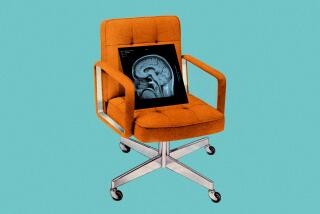Studies of Brain-Diseased Patients Seek Clues to Personal Identity
- Share via
A snippet of tissue in the brain’s frontal lobe has become the focus of science’s quest to find exactly where we get our sense of who we are.
Several recent experiments pinpoint the lobe’s right hemisphere as the locus of our identity.
The study of brain diseases has been a factor in illuminating the research into “self.” People who seem to have lost their sense of self are now said to be suffering from a condition called frontotemporal dementia. Studies have found that damage to the brain’s frontal lobes can not only impair a person’s ability to recognize parts of his or her body, but also cause them to abandon aspects of their daily lives and develop wholly new interests and attitudes. In such cases, scans of the brain have found damage only on the right side.
“It’s as if they’ve lost biographical memories,” said Dr. Bruce Miller, a behavioral neurologist at UC San Francisco who has studied about a dozen patients with right hemisphere damage. The loss of self is actually only the earliest symptom, Miller said, and most cases have progressed to the memory-robbing symptoms common to Alzheimer’s disease.
So, what exactly is the “self”--and how does it develop? Can these recent studies of patients with brain damage provide clues to a search that until recently was largely the province of philosophers? Clearly, one piece of “self” is our ability to recognize ourselves.
Julian Keenan, a neuropsychologist at Montclair State University, has used the latest brain-scanning technology to search for evidence of self recognition. He said the only species capable of recognizing themselves in a mirror are humans, chimps and orangutans. So Keenan set out to figure out how the brain gives rise to self recognition.
In one study, he asked volunteers undergoing an MRI scan to look at two sets of pictures: one of famous people, and one of themselves. Only when they looked at themselves did the right hemisphere’s frontal lobe become activated.
Keenan then asked doctors whether he could test patients during their preparations for neurosurgery. A standard procedure, a Wada test, is performed before neurosurgery to protect important brain processing centers from disturbance. It anesthetizes one hemisphere for a few minutes while the other hemisphere undergoes testing, and then the procedure is reversed.
Keenan took photos of each of five patients who were to undergo neurosurgery. Then, he morphed prints of each patient’s face with a famous face. Each man’s face was morphed with that of Bill Clinton or Albert Einstein. Each woman’s was morphed with Marilyn Monroe’s or Princess Diana’s.
During the Wada procedure, when each hemisphere “slept” for a few minutes, the patient’s brain was scanned as the patient eyed the morphed picture. When the anesthesia wore off, patients were asked who had been in the picture. Patients said they had seen themselves in the picture when the brain’s left hemisphere was asleep. When the right hemisphere was resting, it was the famous person’s face they remembered.
It became clear that the “right hemisphere is important for the phenomenon of experiencing the self,” Keenan said.
Damage to the left hemisphere results in a loss of language or the ability to understand words. Some people with such damage have developed musical and artistic abilities that had been nonexistent, Miller has reported.
His theory is that the right hemisphere, which regulates creativity, is now unleashed to perform its innate ability.
In patient studies, he found that when the right hemisphere suffers damage, the lifelong sense of self evaporates. One involved a middle-age woman who had spent a lifetime clad in designer grays and blues. Suddenly she traded in her wardrobe for flashy reds and yellows. Gourmet restaurants were out. Taco Bell was in.
Another woman, at 57, replaced her conservative wardrobe with sweats. Her passion for collecting fine china was lost to an obsession with teddy bears. Her political allegiances shifted as she forsook conservative causes to work for the environmental group Greenpeace.
At a recent meeting of the American Academy of Neurology, Miller reported on several cases of right hemisphere frontotemporal dementia.
Miller and his colleagues have identified the damage in the brain’s right frontotemporal region and found that the chemical serotonin, known to regulate mood, emotion and behavior, is depleted.
In general, people with damage to the right side of the frontal lobe appear far more comfortable breaking the rules they once created.
While lesions in the frontotemporal region of the brain were identified by Dr. Alois Alzheimer at the turn of the last century, it wasn’t until imaging tools offered a clear view of this structure that doctors could diagnosis this disorder, which was thought to be rare. Since the 1980s, the number of cases diagnosed each year has increased, Miller said. It’s still not clear how many people suffer from it, but it does tend to run in families, Miller said, and generally strikes people between 40 and 65.
Miller estimates that about 75,000 people in the U.S. could have this type of dementia. Such dramatic behavioral change can disrupt the business of living.
*
Jamie Talan is a reporter for Newsday, a Tribune company.






